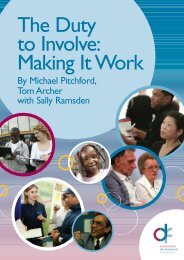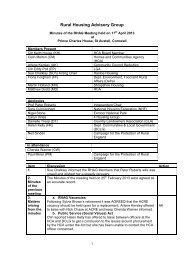Rapid Evidence Assessment of the Research ... - Rural Housing
Rapid Evidence Assessment of the Research ... - Rural Housing
Rapid Evidence Assessment of the Research ... - Rural Housing
Create successful ePaper yourself
Turn your PDF publications into a flip-book with our unique Google optimized e-Paper software.
10. <strong>Evidence</strong> Gaps and<br />
Fur<strong>the</strong>r <strong>Research</strong><br />
Introduction<br />
Sectionhead<br />
204. This chapter considers <strong>the</strong> gaps in <strong>the</strong> evidence base for each <strong>of</strong> <strong>the</strong> eight questions related to second<br />
homes that have been reviewed in Chapters Two to Nine. It also sets out some ideas on <strong>the</strong> methods and <strong>the</strong><br />
information that might be used to improve <strong>the</strong> evidence base.<br />
205. Each <strong>of</strong> <strong>the</strong> eight questions will be considered in turn and <strong>the</strong> research that is needed to fill <strong>the</strong> evidence<br />
gaps will be identified for each question. A concluding section will consider overlaps in <strong>the</strong> possible research<br />
topics and summarise what are believed to be <strong>the</strong> most significant issues on which fur<strong>the</strong>r research is needed<br />
and <strong>the</strong> methods that might be used to examine <strong>the</strong>se issues.<br />
206.<br />
The eight questions that have been considered are:<br />
1. How have ‘second homes’ been defined in <strong>the</strong> literature and what data sources have been used?<br />
2. To what extent (if any) have second homes increased house prices; and have <strong>the</strong>y crowded out prospective<br />
first-time buyers?<br />
3. What specific factors attract people to buy second homes and what types <strong>of</strong> property do <strong>the</strong>y buy, and<br />
where?<br />
4. What is <strong>the</strong> geographical distribution <strong>of</strong> second homes across England, and what are <strong>the</strong> characteristics <strong>of</strong><br />
places with a high concentration <strong>of</strong> second homes?<br />
5. What are <strong>the</strong> social and demographic characteristics <strong>of</strong> those buying second homes?<br />
6. Do households own more than one second home, and what is <strong>the</strong> distribution?<br />
7. Has <strong>the</strong>re been any improvement in <strong>the</strong> supply and quality <strong>of</strong> <strong>the</strong> housing stock as a result <strong>of</strong> second home<br />
purchases?<br />
8. What are <strong>the</strong> social and economic impacts <strong>of</strong> owning second homes?<br />
How have ‘second homes’ been defined in <strong>the</strong> literature and what data sources<br />
have been used?<br />
207. There are several definitions <strong>of</strong> second homes and several associated sets <strong>of</strong> data. These were set out in<br />
Chapter Two. The most quoted definitions and data are those from: (1) The Survey <strong>of</strong> English <strong>Housing</strong>; and (2)<br />
Council Tax records as collated by Communities and Local Government. The Survey <strong>of</strong> English <strong>Housing</strong><br />
definition states that second homes are properties, owned or rented by a household member, which are not<br />
<strong>the</strong> household’s main residence and <strong>the</strong> Council Tax definition is that second homes are furnished dwellings<br />
which are not <strong>the</strong> sole or main residence <strong>of</strong> an individual.<br />
208. The Survey <strong>of</strong> English <strong>Housing</strong>’s latest estimate <strong>of</strong> second homes in England in 2005/6 is 242,000 (CLG,<br />
2007, Table 3.20). This is remarkably close to <strong>the</strong> estimate <strong>of</strong> 240,000 from Council Tax returns (Hansard,<br />
2007). An earlier Survey <strong>of</strong> English <strong>Housing</strong> estimate for 2005/06, based on provisional results, put <strong>the</strong> figure at<br />
260,000 (CLG, 2006b, Table 21). In Chapter Two it was noted that <strong>the</strong>re are strong beliefs in political circles, as<br />
reflected in a parliamentary debate on second homes (Hansard, 2006) that Council Tax data significantly<br />
underestimate <strong>the</strong> number <strong>of</strong> second homes because <strong>of</strong> tax minimising strategies by households. The<br />
suggestion is that some households may choose not to declare a second property as a second home for<br />
Council Tax proposes because <strong>the</strong>ir bill is less if it is recorded as a principal home with single person<br />
occupancy or <strong>the</strong> property is registered for business rates ra<strong>the</strong>r than residential Council Tax.<br />
53






